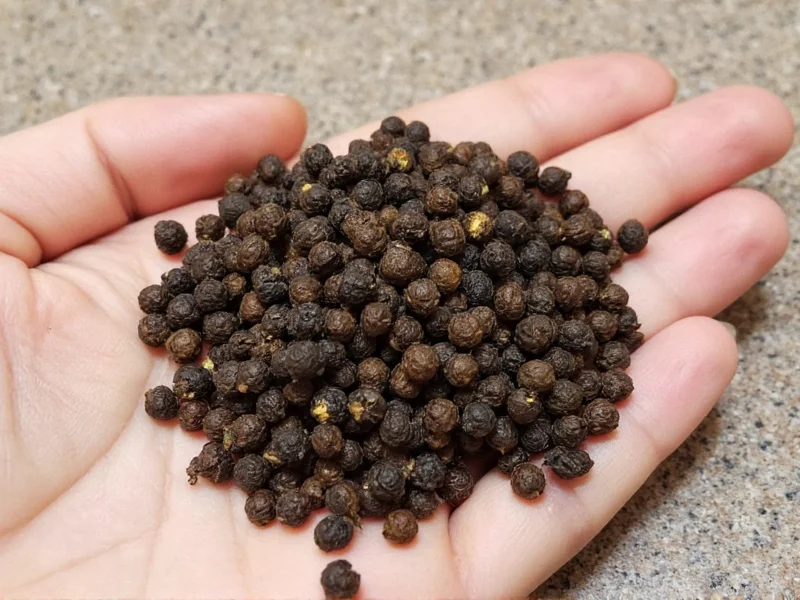Understanding the origin of black pepper begins with recognizing its botanical source. The Piper nigrum plant produces small berry-like fruits that serve as the raw material for black pepper. Unlike what many assume, black pepper isn't a seed but rather the entire dried fruit of this tropical vine.
The Piper Nigrum Plant: Source of Black Pepper
The Piper nigrum vine thrives in tropical climates with consistent warmth and humidity. Native to the Malabar Coast of southwestern India, this perennial plant can grow up to 15 meters high when supported by trees or poles. The vine produces spikes of small flowers that develop into berries. Each berry starts green, then turns red when fully ripe. For black pepper production, harvesters pick these berries when they're still green and unripe.
Black Pepper Production Process
The transformation from fresh berry to black peppercorn involves a precise drying process:
- Harvesting: Workers collect the green berry clusters before full ripening
- Sun-drying: Berries are spread on mats and sun-dried for 3-7 days
- Enzymatic reaction: During drying, enzymes in the outer layer react, turning the berries black
- Shrinking: Moisture loss causes the berries to shrivel into the characteristic wrinkled peppercorns
- Sorting: Finished peppercorns are sorted by size and quality
This traditional sun-drying method creates the complex flavor profile of black pepper, containing approximately 5% piperine—the compound responsible for pepper's pungency and heat.
| Pepper Type | Production Method | Flavor Profile |
|---|---|---|
| Black Pepper | Unripe berries sun-dried | Strong, pungent, complex |
| White Pepper | Ripe berries soaked to remove outer layer | Milder, earthier |
| Green Pepper | Unripe berries preserved | Fresh, herbal |
| Red Pepper | Ripe berries dried | Sweet, fruity |
Historical Significance of Black Pepper
Black pepper has been traded for over 4,000 years, earning the nickname "black gold" in ancient times. Historical records show it was so valuable that it was often used as currency and even accepted as collateral for loans. The quest for direct access to black pepper was a major driving force behind the Age of Exploration, with European powers establishing trade routes specifically to control the spice.
Geographical Indications and Quality Factors
While Piper nigrum grows in many tropical regions today, the highest quality black pepper typically comes from specific regions known for ideal growing conditions. Tellicherry pepper from India's Malabar Coast, Lampang pepper from Thailand, and Sarawak pepper from Malaysia each have distinctive flavor profiles influenced by local soil and climate conditions.
Quality black pepper should have a strong, sharp aroma and a complex flavor with both heat and subtle floral notes. The best peppercorns are uniform in size, dark in color, and free from moisture that could cause mold. When purchasing black pepper, whole peppercorns maintain their flavor significantly longer than pre-ground pepper.
Modern Processing Methods
While traditional sun-drying remains common, some producers now use mechanical drying to ensure consistency. However, many connoisseurs argue that sun-drying creates superior flavor development through the natural enzymatic process. The best black pepper producers carefully monitor moisture content during drying to prevent mold while preserving optimal flavor compounds.
Black Pepper in Culinary and Medicinal Applications
Beyond its role as a seasoning, black pepper has been used in traditional medicine systems for centuries. Modern research suggests piperine may enhance nutrient absorption and have antioxidant properties. In culinary applications, black pepper's versatility makes it suitable for both savory and sweet dishes, with different grind sizes serving distinct purposes—from fine grinds for sauces to coarse grinds for steak crusts.
FAQ
What's the difference between black pepper and white pepper?
Black pepper comes from unripe berries that are sun-dried with their outer layer intact, while white pepper is made from ripe berries with the outer layer removed through soaking. This processing difference creates distinct flavor profiles—black pepper has a stronger, more complex heat, while white pepper is milder and earthier.
Is black pepper made from actual berries?
Yes, black pepper comes from the berry-like fruits of the Piper nigrum vine. Each peppercorn is a single dried berry, not a seed. When ripe, these berries turn red, but for black pepper production, they're harvested while still green and unripe.
Why does black pepper turn black during processing?
The black color develops during sun-drying through an enzymatic reaction. When the green berries are exposed to sunlight and air, enzymes in the outer layer oxidize, causing the berries to turn black and shrivel. This process also develops the characteristic pungent flavor of black pepper.
Can you grow black pepper at home?
Yes, you can grow Piper nigrum at home in tropical or subtropical climates, or as a houseplant in temperate regions. The vine requires warm temperatures (75-85°F), high humidity, partial shade, and support for climbing. It takes 3-4 years for a new plant to produce berries, and you'll need to harvest and dry them properly to make black pepper.
Does black pepper lose potency over time?
Yes, black pepper gradually loses its volatile oils and piperine content over time. Whole peppercorns retain their potency for 2-3 years when stored properly in an airtight container away from light and moisture. Ground pepper loses flavor much faster—within 4-6 months—because the increased surface area accelerates oxidation.











 浙公网安备
33010002000092号
浙公网安备
33010002000092号 浙B2-20120091-4
浙B2-20120091-4